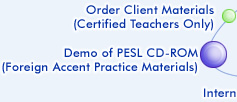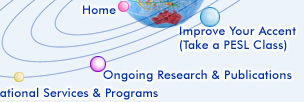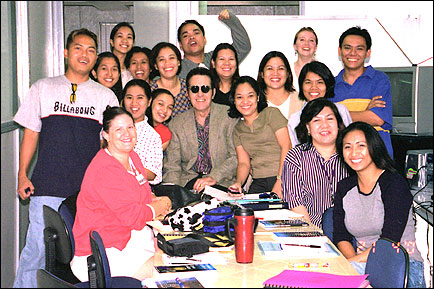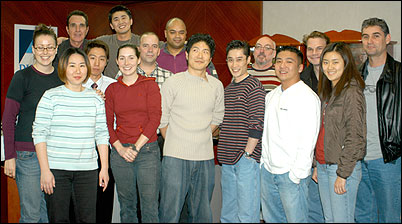 |
International Services & Programs |
 |
 |
 |
|
INTERNATIONAL SERVICES AND PROGRAMS 1) Individuals and Small Groups, 2) Airlines, 3) Banking, 4) CALL CENTERS, 5) Governmental Organizations, 6) Hotels, In addition to the Institute of Language and Phonology: Research Division's domestic services and programs, Dr. Compton has designed, implemented, and conducted international programs for a variety of organizations abroad. One of the primary differences between domestic and international programs is that clients abroad are typically “living” and speaking in their native tongue. Therefore, they have much less opportunity to practice using their newly acquired English speaking skills in their everyday speaking life. Consequently, much more in-class practice must be built into their program, along with a greater reliance upon structured speaking situations to achieve the necessary “transfer – carryover” into habituated speaking. Another difference is the duration of the program. Domestically, courses are typically spread out over three to four months with one or two classes per week, followed by daily homework assignments of one hour per day. The total amount of classroom time is about 25 to 30 hours. This sort of “drawn out” format is impractical, when the program is conducted by an outside contractor from abroad. The Compton P-ESL group program of 25 to 30 hours of classroom work can easily be structured into an intensive two or three week format, with absolutely no loss in quality. All clients who complete their practice assignments, and their employers, can expect a minimum of 50% to 60% accent improvement, regardless of the format of the course, either domestically or internationally. The Compton P-ESL International Programs typically revolve around two primary areas of customized services: I Accent Improvement Services Provided Directly to Non-Native English Speaking Clients Example 1: Several years ago, Dr. Compton designed and provided and intensive one-week Compton P-ESL program for two Levi Strauss key executive personnel based in the Mexico City headquarters. In some cases, as with Levi Strauss, the program may involve only one or two select executive personnel, in which case it is conducted personally and only by Dr. Compton. In other instances, the program may be involve a large number of employees, and it is then designed and managed by Dr, Compton, in conjunction with one or more accompanying associate teachers, depending upon the number of employees. Typically, for larger numbers of individuals (more than 10), the programs are conducted in small groups of 4 or 5 people, with one teacher per group. The length of the program depends upon the schedules and hours of availability of employees for classes, i.e. mornings, afternoons, evenings, weekends, etc. It is best not to extend the program beyond two to three weeks per group. Example 2: Dr. Compton is currently setting up a program for a group of approximately 15 to 20 employees at a large corporation in Buenos Aires, Argentina. Four of these individuals are key executives with very tight and fluctuating schedules, so it is impractical for them to participate in groups, nor do they wish to do so because of their management roles within the company. These individuals will work individually with Dr. Compton, who will accommodate their fluctuating schedules, for approximately two to three weeks. The remaining employees will participate in small group classes for three weeks. The classes will be scheduled for 2 to 3 hours per day, mornings and evenings, and one 6-hour weekend class. II Training Teachers to Provide Accent Improvement Services as an In-House Program This model works best for very large companies, or those needing to provide on-going accent “neutralization” training for many employees, in which case it is becomes excessively expensive and impractical to have all of the training done by outside consultants. This is particularly true for the thousands of Telephone Call Centers, located primarily in India and the Philippines. There are four critical factors that impact the effectiveness and performance value of these workers: a) The intelligibility of the operator, i.e., how well can he/she be understood. Most call center workers have a fairly good command of English, but even a moderate accent can still create intelligibility problems. Moreover, the telephone is a relatively poor transmitter of speech and often magnifies “communication breakdowns”, especially when crossing over from one accent to another. b) The listening comprehension of the operator, i.e., how well can he/she understand the caller. In addition to the listener (caller) not always understanding the operator, it is also often the case that the operator may not understand the “listener's” speech. This, in part, arises from the operator's degree of familiarity with spoken English, but is further complicated by the many dialectical variations of English. The Compton P-ESL Program not only improves intelligibility, but also greatly enhances listening comprehension. c) The foreign accent “mind-set” block. It not uncommon for individuals who have relatively little direct contact and interaction with foreign speakers to “tune out” as soon as they hear an accent. This may be unconscious and unbiased, or consciously prejudicial. Either way the “tuning out” effect is the same; a communication breakdown occurs! Accent training will have little effect in changing this “mind-set.” However, it will substantially help minimize the problem, since the less obvious and identifiable the accent, the less likely the listener will notice. d) The degree of English cultural awareness of the operator. Somewhat similar to the "accent mind-set block," the lack of understanding of basic "English" customs of conducting business and telephone etiquette can often become a major communication barrier. English speakers, generally, have little understanding or patience with any "cultural differences" which are preceived as being inefficient and/or "being talked down to." During the past few years, Dr. Compton has designed In-House Compton P-ESL Programs for several Call Centers. These programs typically begin with selecting the potential teachers from the Call Center personnel who have the best English pronunciation skills. The criterion is “near native” English pronunciation. However, the fact that there may be a few employees with “native” sounding speech does not mean they will automatically be good teachers. This is a mistake that many Call Centers make. A great deal of teacher training is still required to address the issues cited above. Equally important, is a well developed program with effective employee practice materials customized to the specific work setting of the Center. The following example provides an overview of a 3-week combination teacher and employee training program for a Manila based call center. Phase 1 Fourteen potential teachers were selected from the company personnel on the basis of their English speaking skills. For the first week they worked full-time with Dr. Compton and his teaching staff on improving their own speaking skills, using the P-ESL Program. During this time, they not only participated as students, but were also being trained to use the P-ESL methodology with each other. At the end of the first week, 7 of the 14 individuals who displayed the greatest teaching skills were selected to become the In-House teachers for the company. Phase 2 Twenty-one employees were selected to go through a 2-week P-ESL accent improvement program for four hours each day. The program was conducted by the 7 teachers in training, under the constant supervision of Dr. Compton and his assistant. (Note: all Compton P-ESL courses begin with a standardized speech assessment test of each student, and a second identical test at the end of the course. This not only establishes the areas of difficulty for each student, but also allows an objective measure of the amount of improvement). By the end of the course, all 21 employees had achieved at least a 50% reduction in their accents. All seven teachers had a 75% improvement or greater and were essentially native English sounding. Most importantly, the teachers were fully prepared to take over the employee training using the customized P-ESL program that had been developed for the Call Center.
Example 2: In 2004, the Compton P-ESL Program was licensed to, and adopted by, the “Direct English” program of “Pagoda”, the largest language school in South Korea. To launch the P-ESL program, Dr. Compton conducted a 2-day intensive training program for a group of 16 Direct English ESL teachers. The teachers were all native English speakers from several different English speaking countries: Canada, New Zealand ,UK, and USA. The nature of the project was two-fold: 1) to design and introduce a complete (accent improvement) P-ESL testing and teaching program customized specifically for Korean speakers and the unique needs of Direct English, and 2) to train and certify the ESL teaching staff to use this new program. The Compton P-ESL Program has since been successfully incorporated into the Direct English curriculum and is one of their most popular offerings.
|
||

